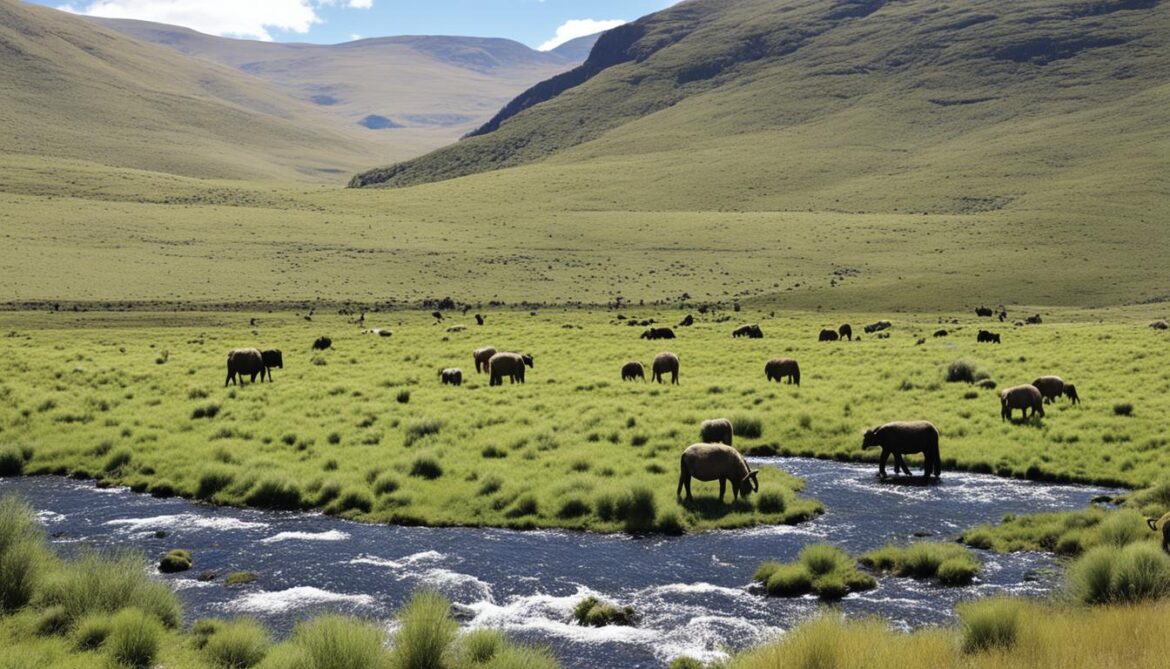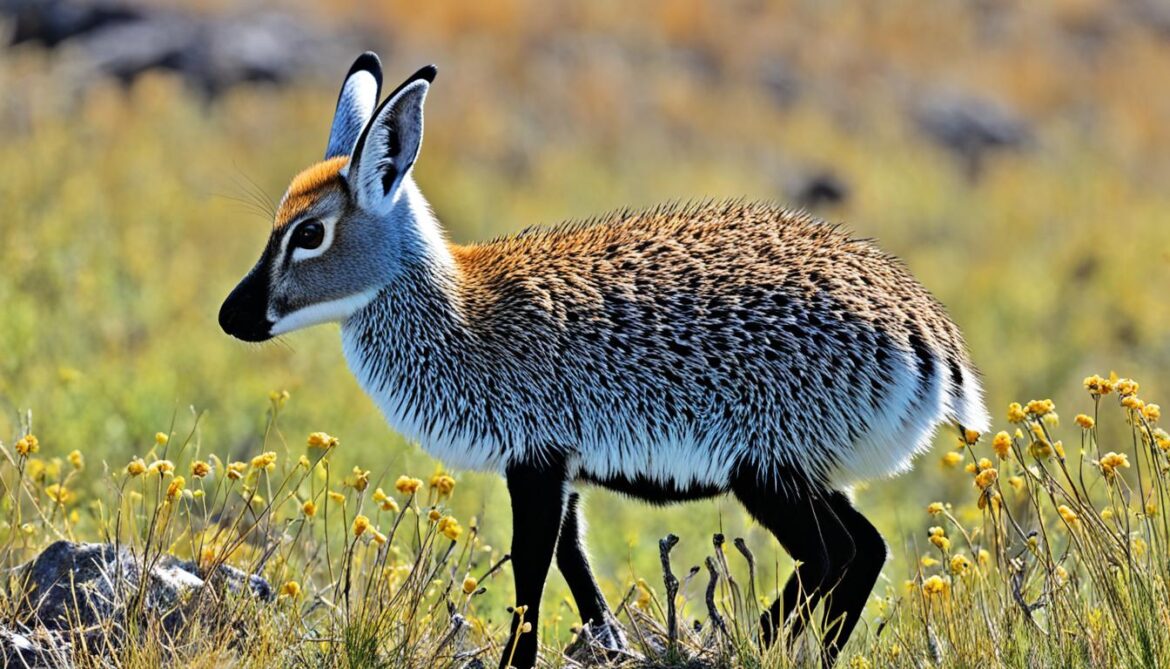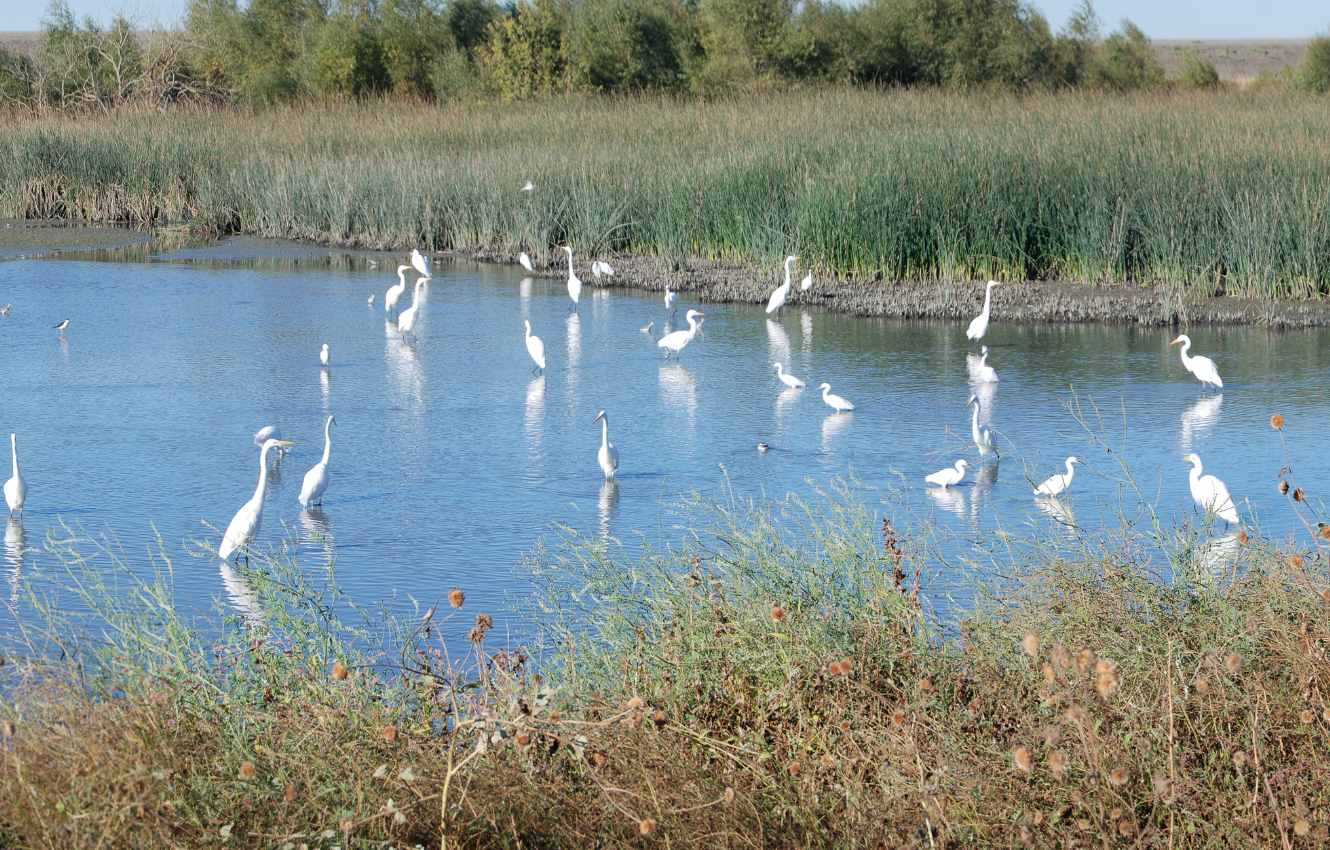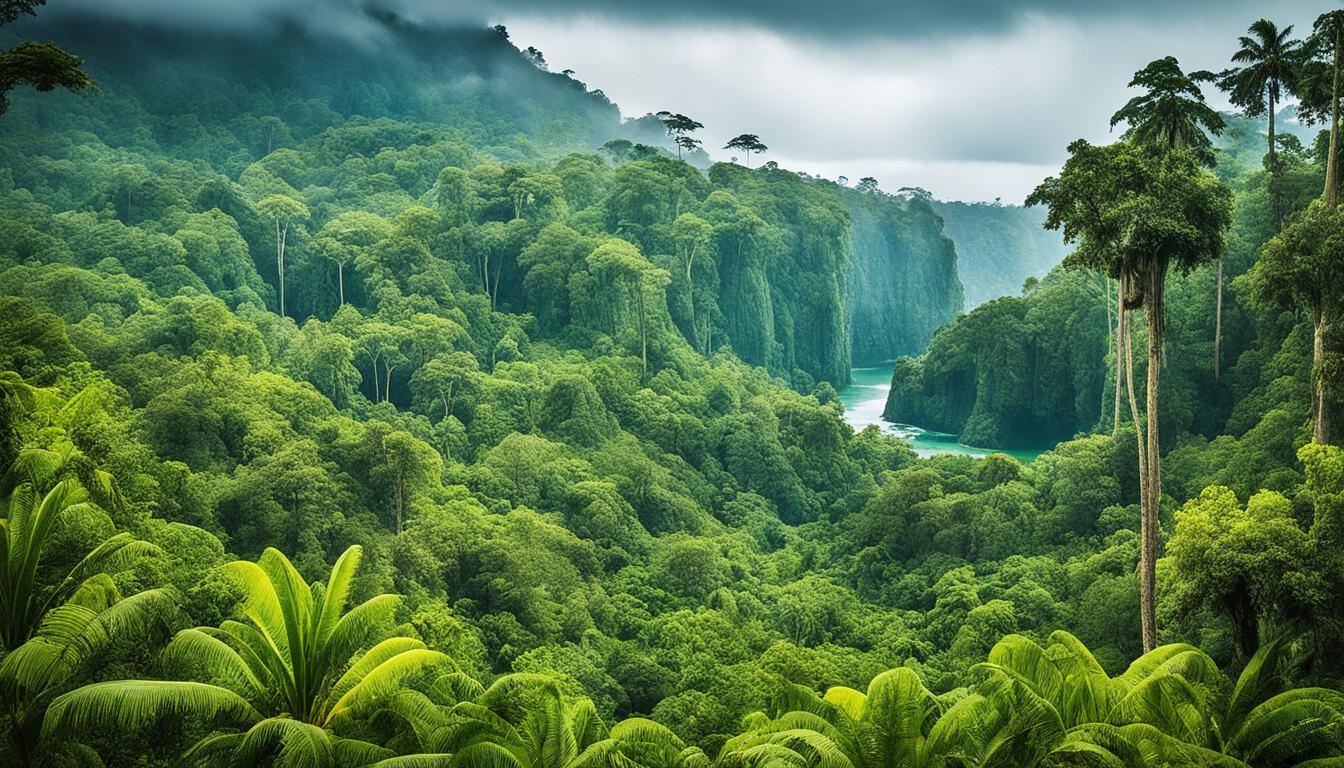Lesotho Biodiversity: Animal and Plant Species and What Is Under Threat
Lesotho, a Party to the Convention on Biological Diversity, is committed to conserving its rich biodiversity. The country has implemented strategies and action plans to protect its unique animal and plant species. However, there are still challenges that pose threats to Lesotho’s biodiversity.
Habitat loss and degradation, particularly in wetlands and rangelands, are significant concerns. Invasive species, changes in fire regimes, and climate change further contribute to the decline of biodiversity. Despite these challenges, Lesotho continues to strive for the conservation and sustainable use of its precious natural resources.
Key Takeaways:
- Lesotho is actively implementing the requirements of the Convention on Biological Diversity.
- Habitat loss, invasive species, and climate change threaten biodiversity in Lesotho.
- The country is committed to conserving its unique animal and plant species.
- Conservation efforts include the development of strategies and action plans.
- Lesotho recognizes the need for sustainable use of its natural resources.
As we delve deeper into Lesotho’s biodiversity, we will explore the country’s conservation efforts and the major components of its diverse ecosystem. We will also highlight the challenges faced and the initiatives taken to preserve this vital natural heritage. Join us on this journey to discover the wonders of Lesotho’s biodiversity and the importance of safeguarding it for future generations.
Introduction to Lesotho’s Biodiversity Conservation Efforts
Lesotho, a proud Party to the Convention on Biological Diversity, is actively engaged in comprehensive biodiversity planning and conservation. The country has spearheaded the development of Biodiversity Strategies and Action Plans (BSAP) to promote the preservation of Lesotho’s diverse ecological heritage. Through the BSAP process, Lesotho collects and analyzes vital information pertaining to the status of its rich biodiversity and the existing threats it faces.
The primary objective of these conservation efforts is to establish a flourishing environment that fosters a balanced existence between people and nature. Lesotho envisions a nation that is economically prosperous, environmentally conscious, and abundant in a wide variety of life forms. By integrating sustainable practices and safeguarding its natural resources, Lesotho is actively contributing to the global efforts in biodiversity conservation.
In order to achieve sustainable development, the Biodiversity Strategies and Action Plans take into account the careful collection and analysis of data regarding Lesotho’s biodiversity. This information is essential for identifying critical conservation areas, understanding the impact of human activities on ecosystems, and developing appropriate measures to mitigate threats. Through robust data collection, Lesotho is able to formulate informed strategies and policies that ensure the protection of its invaluable biodiversity.
“Our goal is to create an environment where biodiversity thrives, and humans coexist harmoniously with nature.” – Lesotho’s Ministry of Environment and Tourism
With an unwavering commitment to conservation, Lesotho actively collaborates with international organizations and initiatives such as the Convention on Biological Diversity. This collaboration facilitates the exchange of knowledge, resources, and best practices, enabling Lesotho to enhance its conservation efforts and promote sustainable development.
Major Biodiversity Components in Lesotho
Lesotho is renowned for its rich and diverse flora and fauna, with a significant number of endemic species. The Drakensberg-Maloti mountains, located in Lesotho, harbor a wide range of high-altitude flora, boasting approximately 3,094 species. Notably, 30% of these species are endemic to these mountains.
Lesotho is also home to a network of unique high-altitude wetlands, which play a pivotal role in the hydrological cycle. These wetlands contribute to water storage, regulation, and purification, providing essential ecosystem services.
The country showcases an incredible variety of taxa, including several endemic species that are found nowhere else on earth. These include the maloti lance craig lizard, the ice rat (Otomys sloggetti), and the water lily (Aponegeton). These unique species have adapted to Lesotho’s specific environmental conditions, further highlighting the country’s exceptional biodiversity.
It is worth noting that while Lesotho’s biodiversity is rich and diverse, the country does not have a significant presence of big game species found in other parts of Africa.
Lesotho’s biodiversity is a testament to the country’s ecological significance and the importance of its conservation efforts.

| Major Biodiversity Components | Examples |
|---|---|
| Flora | Drakensberg-Maloti mountains with approximately 3,094 species, including 30% endemic species |
| Fauna | Endemic species like the maloti lance craig lizard, ice rat (Otomys sloggetti), and water lily (Aponegeton) |
| Wetlands | Unique high-altitude wetlands crucial for the hydrological cycle |
Threats to Biodiversity in Lesotho
In Lesotho, the preservation of biodiversity faces significant challenges due to various threats. Habitat loss and degradation, specifically in wetlands and rangelands, are major concerns. Factors such as overgrazing and uncontrolled fires contribute to the degradation of these habitats, endangering the diverse plant and animal species that rely on them.
Another significant threat to biodiversity in Lesotho is posed by invasive species. These non-native species, both terrestrial and aquatic, disrupt the delicate balance of ecosystems and outcompete native species for crucial resources. Their presence threatens the survival of native flora and fauna, ultimately impacting the overall biodiversity of the region.
Furthermore, climate change amplifies the challenges faced by ecosystems and species in Lesotho. Climate uncertainty is on the rise, leading to unpredictable weather patterns and extreme events. As a result, habitats are further impacted, and the resilience of species is tested. The effects of climate change are also pushing subsistence agriculture further into remaining habitats, exacerbating habitat loss and contributing to the decline of biodiversity.

The Impact of Habitat Loss
“Habitat loss is a pressing concern in Lesotho, endangering the unique ecosystems and species that call this country home. Wetlands and rangelands, essential for supporting a wide range of biodiversity, are particularly vulnerable to human activities and climate-related changes. Urgent conservation efforts are needed to mitigate the long-term impacts of habitat loss and preserve the rich biodiversity of Lesotho.”
Addressing these threats and protecting biodiversity in Lesotho requires a comprehensive approach. Conservation initiatives must prioritize the preservation of key habitats, such as wetlands and rangelands, by implementing sustainable land management practices and fire control measures. Additionally, efforts to prevent the introduction and spread of invasive species are crucial to safeguarding native biodiversity.
Furthermore, proactive measures to mitigate and adapt to the impacts of climate change are essential. These include promoting sustainable agriculture practices, enhancing natural climate resilience through habitat restoration, and raising awareness about the importance of biodiversity conservation in the face of climate uncertainty.
By addressing these threats and implementing effective conservation strategies, Lesotho can protect its unique biodiversity and ensure the continued existence of its diverse plant and animal species for generations to come.
Conservation Challenges and Initiatives in Lesotho
Lesotho faces a range of conservation challenges that require urgent attention. These challenges include the need for improved range management practices, effective fire control measures, and enhanced control of invasive species. These factors pose significant threats to the country’s biodiversity and ecosystems.
One of the key initiatives in addressing these challenges is sustainable development. Lesotho recognizes the importance of balancing economic growth with environmental conservation. By adopting sustainable practices, the country aims to ensure that its development activities align with the long-term preservation of its unique natural heritage.
Conservation education is another crucial initiative undertaken by Lesotho. By raising awareness about the value and fragility of its biodiversity, the country strives to foster a sense of responsibility among its citizens. This education empowers individuals to make informed decisions that positively impact the environment and contribute to biodiversity conservation.
“Conservation is a state of harmony between men and land.”
– Aldo Leopold
Integration of biodiversity conservation into sectoral plans and policies is an essential step in safeguarding Lesotho’s natural resources. By embedding conservation principles at a policy level, the government ensures that biodiversity is considered in all relevant sectors, such as agriculture, forestry, and tourism. This approach helps to minimize the negative impacts of economic activities on the environment and enables sustainable development.
Lesotho recognizes the importance of international collaboration in addressing conservation challenges. The country has sought assistance from renowned organizations such as the Global Environment Facility and the United Nations Development Programme. Through these partnerships, Lesotho gains access to international expertise, funding, and best practices in biodiversity conservation.

Conservation Initiatives in Lesotho
Lesotho has implemented several notable biodiversity initiatives. These initiatives aim to enhance conservation efforts and promote sustainable development.
| Initiative | Description |
|---|---|
| Protected Areas Network | Establishment and management of protected areas to preserve critical habitats and species. |
| Community-Based Conservation | Engaging local communities in conservation activities, empowering them as stewards of their natural resources. |
| Biodiversity Research and Monitoring | Conducting scientific studies and monitoring programs to assess biodiversity status and track changes over time. |
| Environmental Education | Implementing educational programs to raise awareness and foster a culture of environmental stewardship. |
| Ecosystem Restoration | Efforts to restore degraded habitats and promote ecological resilience. |
These initiatives reflect Lesotho’s commitment to biodiversity conservation and its dedication to preserving its unique natural heritage for future generations.
The Importance of Biodiversity for Lesotho’s Economy and Culture
Biodiversity plays a significant role in Lesotho’s economy and culture. The country’s wool and mohair industry, which is crucial for rural communities, relies on the availability of high-quality forage and healthy ecosystems. The diverse plant species provide nutritious grazing resources for livestock, sustaining the livelihoods of many Basotho farmers. Preserving biodiversity is not only essential for the sustainability of the wool and mohair industry but also for the overall economic well-being of Lesotho.
Biodiversity also contributes to the tourism industry, as Lesotho’s unique flora and fauna attract visitors from around the world. Tourists are drawn to the breathtaking landscapes, including the Drakensberg-Maloti mountains and the high-altitude wetlands. Exploring the diverse ecosystems and encountering endemic species such as the maloti lance craig lizard and the beautiful water lily enhances the tourism experience. The revenue generated from ecotourism helps stimulate the local economy, providing employment opportunities and supporting community development projects.
“The preservation of biodiversity goes beyond economic considerations. Certain species and ecosystems hold a deep cultural and spiritual significance for the Basotho people. They are an integral part of our heritage and identity, reflecting our close connection with the natural environment.”
The Basotho people have a strong cultural attachment to nature and value the biodiversity that surrounds them. Many traditional practices and rituals are deeply rooted in the understanding and respect for the natural world. Medicinal plants, for example, play a vital role in traditional Basotho medicine, which has been passed down through generations. The unique flora and fauna of Lesotho not only provide practical benefits but also symbolize the cultural identity and spiritual beliefs of the Basotho people.
Sustainable Development and Biodiversity Conservation
Recognizing the importance of biodiversity for both the economy and culture, Lesotho has taken measures to integrate sustainable development practices into its policies and frameworks. The government has implemented strategies to promote biodiversity conservation while supporting economic growth. Initiatives such as the Lesotho Highlands Water Project, which harnesses the country’s water resources for hydroelectric power generation and water supply to South Africa, demonstrate a commitment to balancing economic development with environmental stewardship.
Conserving the unique biodiversity of Lesotho is not only essential for the country’s current well-being but also for the future generations. By prioritizing the protection and sustainable use of its natural resources, Lesotho can ensure the harmonious coexistence of biodiversity, the economy, and the culture of its people.

| Benefits of Biodiversity for Lesotho | Economy | Culture |
|---|---|---|
| Supports the wool and mohair industry | Provides high-quality forage for livestock | Medicinal plants and traditional Basotho medicine |
| Contributes to the tourism industry | Generates revenue through ecotourism | Cultural identity and spiritual significance |
| Enhances ecosystem services | Water purification and regulation | Traditional practices and rituals |
Research and Monitoring Efforts in Lesotho
Effective biodiversity conservation in Lesotho requires comprehensive research and monitoring efforts. These endeavors play a vital role in understanding the country’s unique biodiversity and implementing effective conservation measures. Through careful studies and data collection, researchers and conservationists can gain valuable insights into species distributions, population dynamics, habitat assessments, and the impacts of climate change on biodiversity.

By collecting data on species richness, endemism, and the threats facing biodiversity, researchers can inform conservation actions and policy-making. This information aids in the identification of key areas that require special attention and resource allocation for conservation efforts. It also enables the prioritization of conservation programs to address the most pressing issues and protect vulnerable species and habitats.
The success of research and monitoring initiatives in Lesotho relies on collaboration between local institutions, international organizations, and various stakeholders. By working together, researchers can benefit from shared expertise, resources, and funding opportunities. This collaboration fosters a holistic approach to biodiversity conservation, encompassing both scientific knowledge and local perspectives.
Recent Research Discoveries
“A recent study conducted by the Lesotho Biodiversity Research Institute revealed the presence of several endemic plant species in the Drakensberg-Maloti mountains. These findings underscore the importance of preserving these unique habitats for the conservation of Lesotho’s rich biodiversity.” – Dr. Sarah Thompson, Lead Researcher, Lesotho Biodiversity Research Institute
Through ongoing research and monitoring efforts, Lesotho can continue to expand its knowledge of biodiversity and develop informed conservation strategies. These efforts are crucial for the long-term protection and sustainable management of the country’s diverse ecosystems and species.
| Research and Monitoring Efforts in Lesotho | Key Findings |
|---|---|
| Biodiversity Surveys | Identification of endemic species and species of conservation concern |
| Population Studies | Insights into population dynamics and trends |
| Habitat Assessments | Evaluation of habitat quality and degradation |
| Climate Change Impacts | Understanding the effects of climate change on biodiversity |
International Collaboration for Biodiversity Conservation in Lesotho
Lesotho recognizes the importance of international collaboration in its efforts to conserve biodiversity. As a dedicated member of global initiatives such as the Convention on Biological Diversity, Lesotho actively engages with the international community to contribute to the global conservation agenda. The country values the exchange of knowledge and expertise, as well as the establishment of partnerships to address critical challenges.
In pursuit of effective biodiversity conservation, Lesotho seeks assistance from esteemed international organizations. The support provided by the Global Environment Facility and the United Nations Development Programme has been valuable in implementing conservation measures across the country. Through these collaborations, Lesotho gains access to resources, technical assistance, and funding opportunities that contribute to the successful implementation of conservation efforts.
The collaboration between Lesotho and international entities fosters shared learning and promotes sustainable development. By leveraging international expertise and best practices, Lesotho aims to address biodiversity conservation challenges effectively. The country values the importance of building strong partnerships and believes that collective efforts are crucial in achieving meaningful and lasting conservation outcomes.
In summary, Lesotho’s commitment to international collaboration in biodiversity conservation reflects its dedication to protecting its unique natural heritage. Through engagement with global initiatives and partnerships with international organizations, Lesotho strives to address conservation challenges while promoting sustainable development.

| International Collaborations | Benefits |
|---|---|
| Convention on Biological Diversity | Access to global conservation knowledge and expertise |
| Global Environment Facility | Resource support and funding opportunities |
| United Nations Development Programme | Technical assistance for conservation projects |
Conclusion
Lesotho’s rich biodiversity is a treasure under threat. Habitat loss, invasive species, and climate change pose significant challenges to the preservation of unique plant and animal species in the country. However, Lesotho has shown commitment and determination in addressing these threats.
Biodiversity planning, conservation initiatives, and research and monitoring efforts have been key in the fight to protect Lesotho’s natural heritage. The country’s dedication to sustainable development and the recognition of the importance of biodiversity for its economy and culture contribute to ongoing conservation efforts.
International collaboration plays a crucial role in supporting Lesotho’s conservation endeavors. With effective strategies and action plans in place, Lesotho aims to safeguard its extraordinary biodiversity for future generations to enjoy and cherish.








